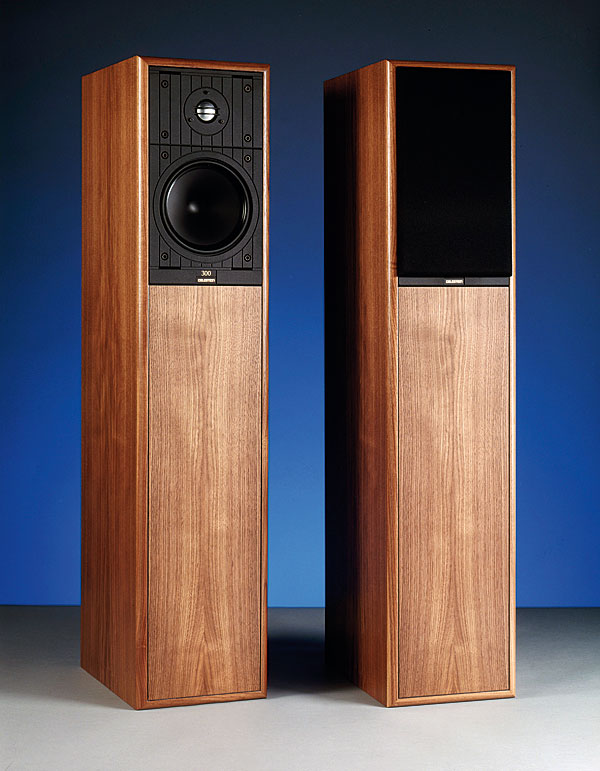Celestion 300 floorstander Page 2
Draw The Line
The drawings show the development of the Celestion line. In [a] the driver is loaded by a simple pipe with the first 1⁄4 acoustic mode shown within; [b] shows a well-lagged pipe which attenuates the shorter-wavelength higher-frequency modes at the expense of an overall loss. In [c] a taper is introduced, which in theory offers a sort of filtering action but in practice is ineffective. In figure [d] the Letts idea of expansions and restrictions is introduced, these lumped acoustic components designed to operate as a filter. In [e] the expansion chamber is seen, which is developed with the adjacent line position in [f].
Chamber Music
The cabinet rear view shows the line exit on the lower back section of the speaker, while the cutaway side view shows the line arrangement. The region behind the driver is built as a series of cascaded chambers with foam acoustic resistance pads in the communicating apertures. The line begins just behind the driver, its length folded into the larger, lower section of the enclosure. Constructed entirely of 15mm MDF, the labyrinthine internal structure exploits the compartment sections as side panel braces, reducing coloration from this source.

Turning to the drivers, the uppermost is the long-throw 32mm aluminium alloy dome tweeter first seen in the SL6S. This pistonic unit uses a one-piece dome and ventilated coil former, suspended on a doped fabric surround. Below is the famous SL series bass unit, a 170mm driver built on a new cast alloy frame and fitted with the established one-piece Cobex vacuum-moulded cone. Celestion's unusual two-part surround combines rubber at the outer perimeter and plasticised vinyl on the inner ridge.
The crossover uses selected polypropylene film capacitors and a mix of air core and high power ferrite inductors. The crossover point is set at 2.2kHz with a 2nd order electrical network approximating to 3rd order Butterworth characteristics.
![]() Deep Thinking
Deep Thinking
While power amplifiers such as the Krell KST100 gave good service with the 300, the best match turned out to be the Meridian 605 monoblocks. The speaker load suited them while their full power drove the 300 to decent levels in full control at 150W-plus per channel on undistorted programme. Direct drive was possible from the Accuphase DP-70V CD player in balanced mode (both with the Krell and Meridian amps) and the results were impressive. Driving at high power from vinyl sources, some cone flutter was evident with the 300, indicating that a preamp with some subsonic filtering would be preferable to the unfiltered drive of the Conrad- Johnson PF-1 preamp used for test.

First impressions were of a smooth-sounding loudspeaker with fine stereo focus and a notably extended bass. Moving quickly to some favourite cathedral organ tracks, it was clear that the 300 was able to plumb the depths and could produce satisfying levels of fundamental bass. Yet the speaker remained in control at low frequencies and did not give any impression of looseness or poor damping. When a heavy bass content was present in the programme, the 300 could take peak powers approaching 100W without significant distortion – though there are understandable limits when the main bass driver is only 130mm in effective diameter.
Compared with past SL models, the 300 speaks with a quality of foundation and gravitas absent from the former examples. The upper bass was not thought quite so articulate as the smaller free space boxes and was a touch prominent in my room. Nevertheless, the overall sense of balance of the SL series was preserved, and in situ, the bass, mid and treble ranges were well proportioned and well balanced.
Stereo image focus was very good. The image was presented closer than, say, an SL600 and percussion had a more forceful impact. By comparison, perspectives were foreshortened and less depth and ambience were apparent. The 300 performance was still good in this respect, though.
Coloration Scheme
When it came to coloration, this was comparatively low. Multi-bracing has been notably successful in keeping 'woody' panel resonances at bay, while the drivers are of proven performance. The midrange might have sounded more 'open' and could appear cloudy at times with certain piano notes. The treble is smooth and clear, though some moderate emphasis is present in the middle of the treble register.
This adds a sense of 'speed' and attack to transients but is also associated with hardness and a degree of metallic exaggeration to wood block and small drum sounds. This was apparent with some recordings on CD, eg, Paul Simon's The Rhythm Of The Saints. A better sense of air in the upper treble would also be welcome.

Dynamics were unexceptional, and given the overall quality of the system this aspect rated 'average plus'. 'Timing' was thought pretty good through the mid and treble ranges but the bass was a touch late, with a loss of drive and pace. In this sense, the 300 did rather better on large-scale classical orchestral material than on fast rock.
Conclusion
For its size and price the Celestion 300 has a remarkably extended low frequency register. It plays classical programme on a big scale, and may reveal unexpected low-bass content in many rock tracks. More capable of 'tune playing' than the usual transmission line, the 300 is, even so, not a very 'fast' or dynamic loudspeaker and is better suited in this respect to classical rather than rock material.
Essentially well balanced and clean, it is worth hearing the 300, particularly if low bass is high on your list. While the efficiency is low, it offers some compensation in the shape of its kind load impedance, which suits both valve and solid state amplification alike.
If assessed as a straightforward two-way speaker, the 300 would seem to be a marginal case in respect of recommendation. But add in the integral 'pillar-stand' and the unusual bass extension and the balance tips in Celestion's favour.


















































